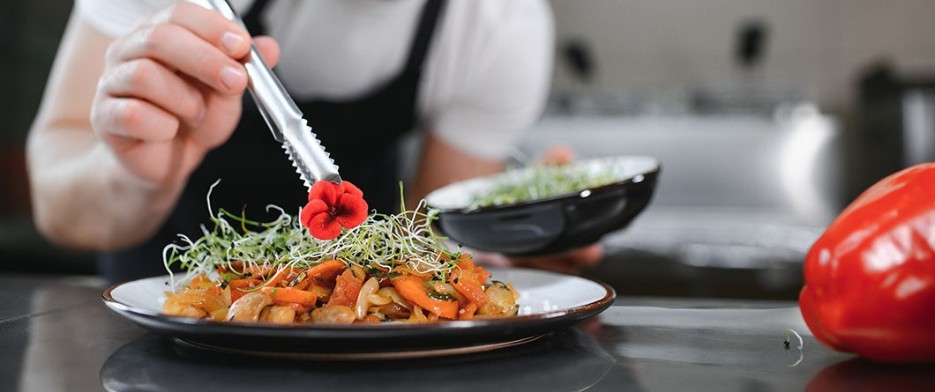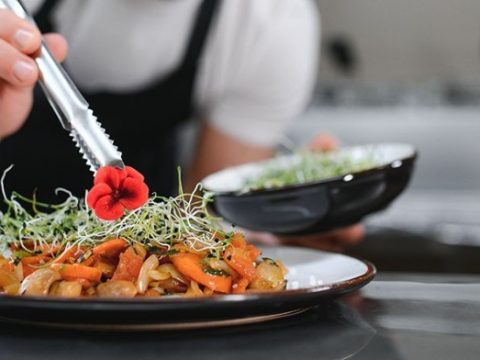The Art of Plating: Tips and Tricks for Creating Stunning Plates
Food tastes better when it looks good on the plate. This isn’t just empty talk—it’s supported by numerous studies and centuries of home cooks fine-tuning their presentations (think the classic lettuce leaf under the meat or the parsley sprig on top of a potato salad).
You don’t have to be a culinary Picasso. A few small efforts can transform an ordinary plate into one that begs to be photographed before it’s savored.
Grab your tweezers, choose your prettiest serving dishes, and fill a squeeze bottle with a balsamic reduction. It’s time to make your food not only delicious but also unforgettable at first glance.
What Is Plating?
Plating is the practice of arranging and decorating food on a plate to enhance its visual appeal. A well-plated dish should look appetizing, be neat and orderly, and highlight the colors, textures, and components of the recipe.
The concept dates back to 17th-century France, when King Louis XIV instructed his chefs to present food in the most elegant way possible. The English term “plating” comes from “plate,” meaning the dish itself. So avoid redundant phrases like “plate plating.”
Basic Principles of Plating
- Balance: Don’t overcrowd one side of the plate, leaving the other empty.
- Margins: Keep food away from the rim of the plate.
- Odd Numbers: Arrange elements in odd-numbered groupings (e.g., three slices of protein).
- Focus: The main ingredient should be the star—position it prominently, not buried under garnishes.
- Edibility: Everything on the plate must be edible—no plastic leaves or pebble decorations. Natural containers (shells, nutshells) and food-support tools (skewers) are exceptions.
Techniques for Arranging Food
Before adding edible flowers or painting sauce on the plate, master the basics of arranging food so that elements complement or highlight each other:
- Rule of Thirds: Mentally divide the plate into three sections—for protein, starch, and vegetables—rather than placing the protein dead center.
- Symmetry vs. Asymmetry: Symmetric arrangements feel orderly and classic; asymmetric ones feel dynamic and modern.
- Separation: Serve starches and proteins side by side rather than stacking them into a mush.
- Negative Space: Leaving empty areas around the food draws the eye to the dish and creates a breathable, elegant look.
- Color Pairing: Place bold-colored ingredients next to each other—roasted beet, matcha powder, blueberries, or edamame—to create a visual “wow” factor.
Plating Styles for Inspiration
Vertical Layering
Create height and drama by stacking or propping elements:
- Grilled vegetable slices layered with a ball of fresh mozzarella drizzled with balsamic reduction.
- Lamb chops standing upright with the bone pointing up.
- Polenta rounds stacked as a base for a sauced stew or steak.
Varied Heights
Use components of different heights for depth:
- Underlay items with a thin toast or cracker to lift elements.
- Place mousses or foams on top of solids for vertical interest.
Geometric Plating
Employ straight lines and shapes for a refined presentation:
- Arrange vegetables or sauces in parallel lines.
- Use metal molds to shape rice or grains into squares or cylinders.
Color-Block Plating
Combine vibrant purees and sauces for a striking palette. Swap parsley for microgreens, citrus zest, or edible flowers for creative garnish.
“Landscape” Plating
Craft a miniature scene on the plate—ideal for playful family meals:
- Use microgreens as “grass” or “trees.”
- Ground nuts or breadcrumbs can mimic sand or soil.
Remember that spectacular plating can’t save a bland dish. Strive for harmony between taste and visual design to create truly exceptional plates.


